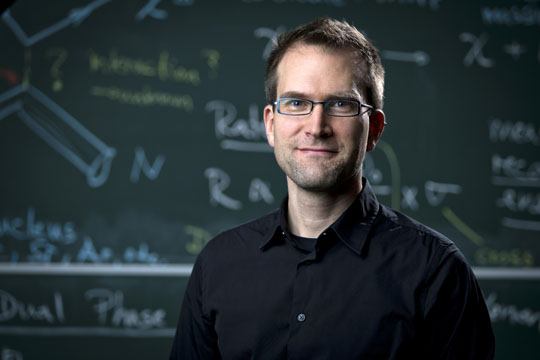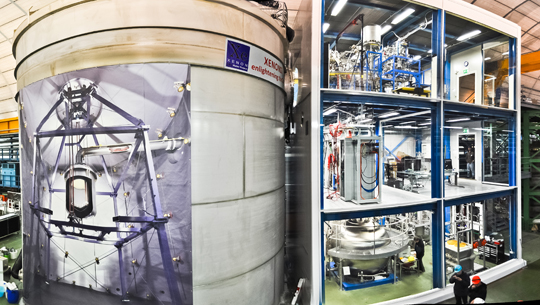Intangible and everywhere at the same time
Freiburg, Aug 29, 2017
It is everywhere and yet invisible at the same time: dark matter. Researchers are convinced it is what holds the universe together. But up until now no one has been able to prove its existence. Together with a 130 member international team, Marc Schumann, Freiburg Professor for Experimental Astroparticle Physics wants to uncover the yet to be discovered particles. He received a Consolidator Grant from the European Research Council (ERC) for his work in 2017. Schumann wants to create the basis for a new kind of detector with the two million euros he has received in order to push the quest to find dark matter to its feasible limits. The University of Freiburg is celebrating the ERC grant's tenth anniversary along with its 50 recipients with a look at select projects. A new series will portray ten of them.
 Open secret: It holds the galaxies together like a kind of cosmic glue, but no one has been able to prove its existence.
Open secret: It holds the galaxies together like a kind of cosmic glue, but no one has been able to prove its existence.
Photo: McCarthys_PhotoWorks/Fotolia
Marc Schumann is a basic researcher with all his heart and soul. "The practical application of actually proving dark matter exists would be of zero value," he says, laughing. And yet a successful discovery of it would make waves worldwide. Research would finally have new points of departure to understand how particles and universal forces interact. Schumann finds it exciting to draw closer to the questions of the universe using precise measuring techniques. "People often ignore the fact that basic research develops new technologies in order to find solutions to questions that then find a broader use," he emphasizes. Today's Internet is just one example. It was originally developed because particle physicists needed to transfer large amounts of data.
 Marc Schuman wants to design a new type of detector with his ERC project ULTIMATE.
Marc Schuman wants to design a new type of detector with his ERC project ULTIMATE.
Photo: Jürgen Gocke
Originally, Schumann wanted to enter the field of astronomy. But it wasn't precise enough for him so he opted to enter astroparticle physics instead. "In this field I was able to connect astronomy that deals a lot with observation and cataloguing with precise research methods," he says. In contrast to high energy physics, particles are not artificially accelerated in order to collide with one another to create new particles. Instead, researchers use delicate measuring devices to merely observe the particles that are a natural part of space.
The researchers are currently working with the detector XENON1T that is one and a half kilometers beneath the Earth's surface in Italian region of Abruzzo. The detector has been submerged in order to shut out as much cosmic radiation as possible, which might otherwise interfere with the measurements.
 The detector XENON1T is located one and a half kilometers beneath the Earth's surface, thereby eliminating cosmic radiation that would otherwise interfere with measurements.
The detector XENON1T is located one and a half kilometers beneath the Earth's surface, thereby eliminating cosmic radiation that would otherwise interfere with measurements.
Photo: XENON1T
Three tons of noble gas beneath the Earth's surface
The high-tech device is made up of a one by one meter container, much like a thermos, that is densely filled with three tons of liquid xenon. This noble gas is locked in a gigantic water tank that is intended to keep as much nuclear radiation as possible at bay. Xenon is used because particle radiation can produce light and electric charge signals in it. Highly sensitive sensors are placed in the detector that can register the tiniest of signals. Dark matter and other particles have only the slightest of interactions, which makes it difficult to prove such a collision. "The trick is to find these rare events with the detector," explains Schumann.
Dark matter can only be identified indirectly on the basis of specific particle movements within the xenon nuclei. The sensors can only register the rebounding movement of the particles, much like a game of billiard: the white ball that creates the movement – in this case, the dark matter – remains invisible. The Freiburg research team's specialty is to select, analyze and interpret the enormous amounts of data the sensors produce.
Dominant background
Radioactive processes, in particular radon's disintegration, are still interfering with the measurements in the current detector. For that reason, Schumann and his team are now working on designing an even more sensitive device that can only be penetrated by neutrinos, particles that cannot be shielded anyway. "If we actually get to the point that neutrinos are the only interfering background signals, we will still not be able to prove that dark matters exists. Because then the neutrino background will dominate and it acts precisely the way dark matter would," explains Schumann.
At first glance, that might seem rather unsettling, but Schumann doesn't find the scenario to be particularly alarming. "In that case, it is just as relevant to have found nothing," he says. Even that would open doors for theoreticians to answer unresolved questions about the universe. After all, that's what particle physics is all about. But getting to that understanding is a long way off. And that dark matter might show up in the detectors after all is still a possibility.
Petra Völzing

